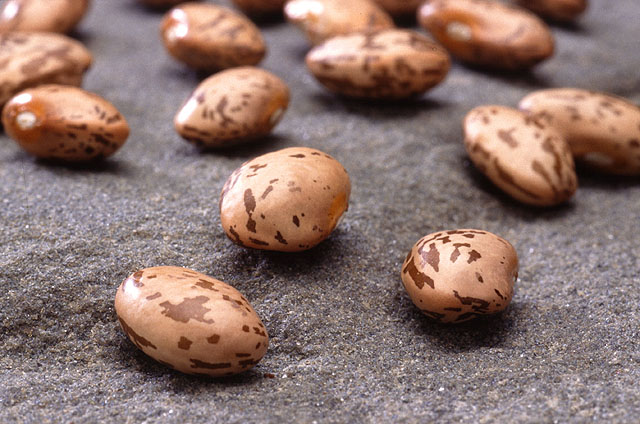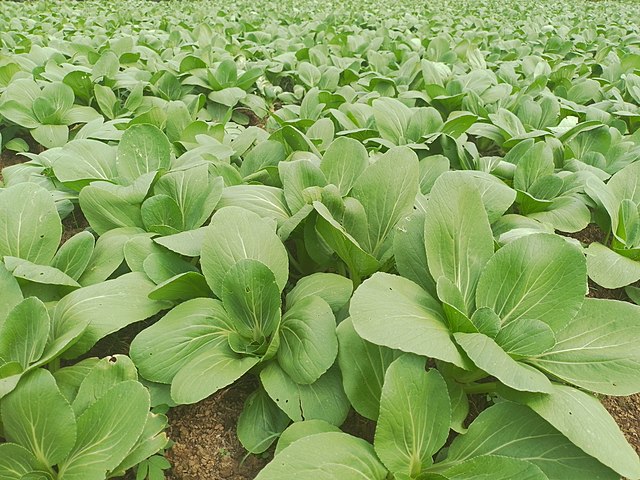Pinto Beans vs. Bok Choy
Nutrition comparison of Pinto Beans and Bok Choy
Ever wonder how your favorite foods stack up against each other in terms of nutrition?
We compared the nutritional contents of
pinto beans
versus
bok choy
(100g each)
below using 2020 USDA and NIH data[1].
For a quick recap of significant nutrients and differences in pinto beans and bok choy:
- Both bok choy and pinto beans are high in calcium and potassium.
- Bok choy has 8.2 times less carbohydrates than pinto bean.
- Bok choy has more riboflavin, pantothenic acid, Vitamin B6 and folate.
- Bok choy is an excellent source of Vitamin A and Vitamin C.
- Pinto bean is an excellent source of dietary fiber.
USDA sources for nutritional information: Pinto Beans (Beans, pinto, canned, drained solids) and Bok Choy (Cabbage, chinese (pak-choi), raw) . Have a correction or suggestions? Shoot us an email.
Calories and Carbs
calories
Pinto bean is high in calories and bok choy has 89% less calories than pinto bean - bok choy has 13 calories per 100 grams and pinto bean has 114 calories.
For macronutrient ratios, pinto beans is lighter in protein, heavier in carbs and similar to bok choy for fat. Pinto beans has a macronutrient ratio of 24:69:7 and for bok choy, 39:53:8 for protein, carbohydrates and fat from calories.
Macro Ratios from Calories:
| Pinto Beans | Bok Choy | |
|---|---|---|
| Protein | 24% | 39% |
| Carbohydrates | 69% | 53% |
| Fat | 7% | 8% |
| Alcohol | ~ | ~ |
carbohydrates
Bok choy has 8.2 times less carbohydrates than pinto bean - bok choy has 2.2g of total carbs per 100 grams and pinto bean has 20.2g of carbohydrates.
dietary fiber
Pinto bean is an excellent source of dietary fiber and it has 450% more dietary fiber than bok choy - bok choy has 1g of dietary fiber per 100 grams and pinto bean has 5.5g of dietary fiber.
sugar
Bok choy and pinto beans contain similar amounts of sugar - bok choy has 1.2g of sugar per 100 grams and pinto bean has 0.54g of sugar.
Protein
protein
Pinto bean has 366% more protein than bok choy - bok choy has 1.5g of protein per 100 grams and pinto bean has 7g of protein.
Fat
saturated fat
Both bok choy and pinto beans are low in saturated fat - bok choy has 0.03g of saturated fat per 100 grams and pinto bean has 0.16g of saturated fat.
Vitamins
Vitamin C
Bok choy is an excellent source of Vitamin C and it has 449 times more Vitamin C than pinto bean - bok choy has 45mg of Vitamin C per 100 grams and pinto bean has 0.1mg of Vitamin C.
Vitamin A
Bok choy is an excellent source of Vitamin A and it has more Vitamin A than pinto bean - bok choy has 223ug of Vitamin A per 100 grams and pinto bean does not contain significant amounts.
Vitamin E
Bok choy and pinto beans contain similar amounts of Vitamin E - bok choy has 0.09mg of Vitamin E per 100 grams and pinto bean does not contain significant amounts.
Vitamin K
Bok choy has more Vitamin K than pinto bean - bok choy has 45.5ug of Vitamin K per 100 grams and pinto bean does not contain significant amounts.
The B Vitamins
Bok choy has more riboflavin, pantothenic acid, Vitamin B6 and folate. Both pinto beans and bok choy contain significant amounts of thiamin and niacin.
| Pinto Beans | Bok Choy | |
|---|---|---|
| Thiamin | 0.052 MG | 0.04 MG |
| Riboflavin | 0.019 MG | 0.07 MG |
| Niacin | 0.272 MG | 0.5 MG |
| Pantothenic acid | ~ | 0.088 MG |
| Vitamin B6 | ~ | 0.194 MG |
| Folate | 24 UG | 66 UG |
Minerals
calcium
Both bok choy and pinto beans are high in calcium. Bok choy has 67% more calcium than pinto bean - bok choy has 105mg of calcium per 100 grams and pinto bean has 63mg of calcium.
iron
Pinto bean has 66% more iron than bok choy - bok choy has 0.8mg of iron per 100 grams and pinto bean has 1.3mg of iron.
potassium
Both bok choy and pinto beans are high in potassium. Bok choy is very similar to bok choy for potassium - bok choy has 252mg of potassium per 100 grams and pinto bean has 274mg of potassium.
Omega-3 and Omega-6
omega 3s
For omega-3 fatty acids, pinto bean has more alpha linoleic acid (ALA) than bok choy per 100 grams.
| Pinto Beans | Bok Choy | |
|---|---|---|
| alpha linoleic acid | 0.158 G | 0.055 G |
| Total | 0.158 G | 0.055 G |
omega 6s
Comparing omega-6 fatty acids, pinto bean has more linoleic acid than bok choy per 100 grams.
| Pinto Beans | Bok Choy | |
|---|---|---|
| linoleic acid | 0.115 G | 0.042 G |
| Total | 0.115 G | 0.042 G |
Customize your serving size
The comparison below is by common portions, e.g. cups, packages. You can also see a more concrete comparison by weight at equal weight (by grams) comparison.
Note: The specific food items compared are: Pinto Beans (Beans, pinto, canned, drained solids) and Bok Choy (Cabbage, chinese (pak-choi), raw) .
Pinto Beans g
()
|
Daily Values (%) |
Bok Choy g
()
|
|||||
|---|---|---|---|---|---|---|---|
| KCAL % |
|
5% | calories | 5% |
|
KCAL % | |
| G % |
|
5% | carbohydrates | 5% |
|
G % | |
| G % |
|
5% | dietary fiber | 5% |
|
G % | |
| G | 5% | sugar | 5% | G | |||
| G % |
|
5% | total fat | 5% |
|
G % | |
| G % |
|
5% | saturated fat | 5% |
|
G % | |
| G | 5% | monounsaturated fat | 5% | G | |||
| G | 5% | polyunsaturated fat | 5% | G | |||
| G | 5% | trans fat | 5% | G | |||
| MG | 5% | cholesterol | 5% | MG | |||
| MG % |
|
5% | sodium | 5% |
|
MG % | |
| 5% | Vitamins and Minerals | 5% | |||||
| UG % |
|
5% | Vitamin A | 5% |
|
UG % | |
| MG % |
|
5% | Vitamin C | 5% |
|
MG % | |
| IU % |
|
5% | Vitamin D | 5% |
|
IU % | |
| MG % |
|
5% | calcium | 5% |
|
MG % | |
| MG % |
|
5% | iron | 5% |
|
MG % | |
| MG % |
|
5% | magnesium | 5% |
|
MG % | |
| MG % |
|
5% | potassium | 5% |
|
MG % | |
| MG % |
|
5% | thiamin (Vit B1) | 5% |
|
MG % | |
| MG % |
|
5% | riboflavin (Vit B2) | 5% |
|
MG % | |
| MG % |
|
5% | niacin (Vit B3) | 5% |
|
MG % | |
| MG % |
|
5% | Vitamin B6 | 5% |
|
MG % | |
| MG % |
|
5% | pantothenic acid (Vit B5) | 5% |
|
MG % | |
| UG % |
|
5% | folate (Vit B9) | 5% |
|
UG % | |
| UG % |
|
5% | Vitamin B12 | 5% |
|
UG % | |
| MG % |
|
5% | Vitamin E | 5% |
|
MG % | |
| UG % |
|
5% | Vitamin K | 5% |
|
UG % | |
| G % |
|
5% | protein | 5% |
|
G % | |
| UG % |
|
5% | biotin (Vit B7) | 5% |
|
UG % | |
| MG % |
|
5% | choline | 5% |
|
MG % | |
| MG % |
|
5% | chlorine | 5% |
|
MG % | |
| UG % |
|
5% | chromium | 5% |
|
UG % | |
| MG % |
|
5% | copper | 5% |
|
MG % | |
| UG % |
|
5% | fluoride | 5% |
|
UG % | |
| UG % |
|
5% | iodine | 5% |
|
UG % | |
| MG % |
|
5% | manganese | 5% |
|
MG % | |
| UG % |
|
5% | molybdenum | 5% |
|
UG % | |
| MG % |
|
5% | phosphorus | 5% |
|
MG % | |
| UG % |
|
5% | selenium | 5% |
|
UG % | |
| MG % |
|
5% | zinc | 5% |
|
MG % | |
| G | 5% | Water | 5% | G | |||
| G | 5% | Starch | 5% | G | |||
| G | 5% | Alcohol | 5% | G | |||
FAQ
Does bok choy or pinto beans contain more calories in 100 grams?Pinto bean is high in calories and bok choy has 90% less calories than pinto bean - bok choy has 13 calories in 100g and pinto bean has 114 calories.
Is bok choy or pinto beans better for protein?
Pinto bean has 370% more protein than bok choy - bok choy has 1.5g of protein per 100 grams and pinto bean has 7g of protein.
Does bok choy or pinto beans have more carbohydrates?
By weight, bok choy has 8.2 times fewer carbohydrates than pinto bean - bok choy has 2.2g of carbs for 100g and pinto bean has 20.2g of carbohydrates.
Does bok choy or pinto beans contain more calcium?
Both bok choy and pinto beans are high in calcium. Bok choy has 70% more calcium than pinto bean - bok choy has 105mg of calcium in 100 grams and pinto bean has 63mg of calcium.
Does bok choy or pinto beans contain more potassium?
Both bok choy and pinto beans are high in potassium. Bok choy is very similar to bok choy for potassium - bok choy has 252mg of potassium in 100 grams and pinto bean has 274mg of potassium.

